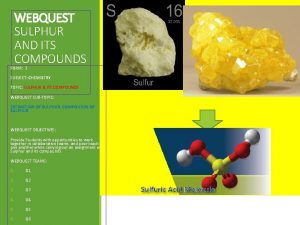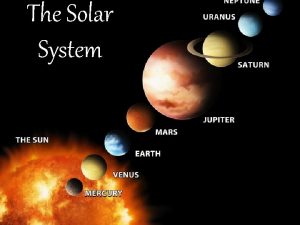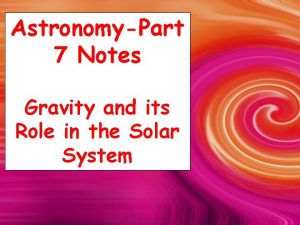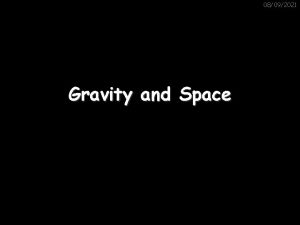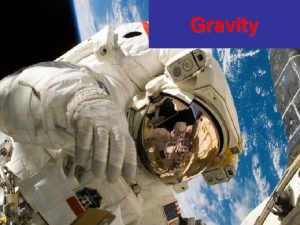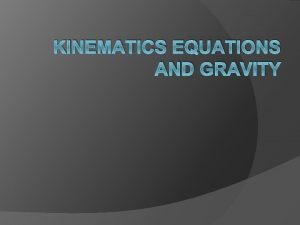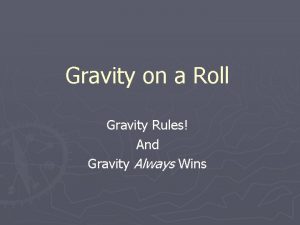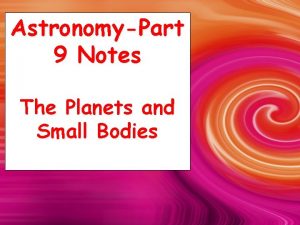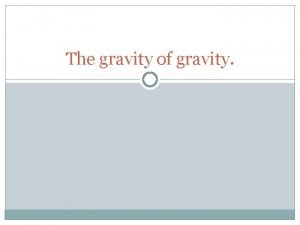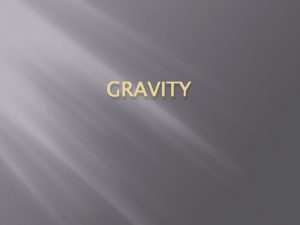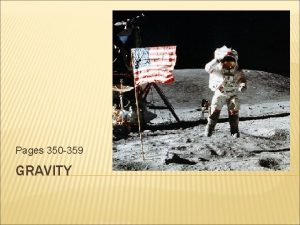AstronomyPart 7 Notes Gravity and its Role in














- Slides: 14

Astronomy-Part 7 Notes Gravity and its Role in the Solar System

What is Gravity? • Gravity is a force of attraction between objects that is due to their masses and the distances between them. • Every object in the universe pulls on every other object. Objects with greater masses have a greater force of attraction than objects with lesser masses have. • Objects that are close together have a greater force of attraction than objects that are far apart have. • Gravity is the weakest force in nature, yet it is one of the most important forces in the universe.

What is Gravity? • Gravity accounts for the formation of planets, stars, and galaxies. • Gravity also keeps smaller bodies in orbit around larger bodies. • An orbit is the path that a body follows as it travels around another body in space.

Kepler’s Laws (Again). • The 16 th century Polish astronomer Nicolaus Copernicus changed our view of the solar system. • He discovered that the motions of the planets could best be explained if the planets orbited the sun. • Like astronomers before him, Copernicus thought that the planets followed circular paths around the sun. • Danish astronomer Tycho Brahe used special instruments to accurately measure planetary motions over a period of 20 years. • Using Tycho’s data, Johannes Kepler discovered what we call Kepler’s laws of planetary motion.

Kepler’s First Law • Upon plotting the orbit of Mars, Kepler saw that it was a deformed circle. • After eight years of work, he realized that it was an ellipse. • Kepler then proposed that each of the planets has an elliptical orbit, with the sun at one focus of the ellipse. • This is Kepler’s first law.

Planetary Motion • When an object follows an elliptical orbit around the sun, there is one point, called aphelion, where the object is farthest from the sun. • There is also a point, called perihelion, where the object is closest to the sun. • Today, we know that the orbits of the planets are only slightly elliptical, but the orbits of objects such as Pluto and comets are highly elliptical.

Kepler’s Second Law • Kepler found that a planet moves slower at aphelion, sweeping out a narrow sector on the ellipse. • Conversely, a planet moves faster at perihelion, sweeping out a thick sector on the ellipse. • As a planet moves around its orbit, it sweeps out equal areas in equal times. This is Kepler’s second law.

Kepler’s Third Law • Kepler looked at how long it took for the planets to orbit the sun. He also observed the sizes of their orbits. • He discovered that the square of the orbital period is proportional to the cube of the planet’s distance from the sun. • This principle is Kepler’s third law.

Law of Universal Gravitation • Using Kepler’s laws, Sir Isaac Newton became the first scientist to mathematically describe how the force of gravity behaves. • He reasoned that gravity is the force that accounts for both the fall of an apple from a tree and the movement of the moon around Earth. • In 1687, Newton formulated the law of universal gravitation.

Law of Universal Gravitation • The law of universal gravitation states that all objects in the universe attract each other through gravitational force. • The strength of this force depends on the product of the masses of the objects. • Gravitational force is also inversely proportional to the square of the distance between the objects.

Law of Universal Gravitation • Equation: Where: Fg: Gravitational Force G: Universal Gravitational Constant (6. 67 x 10 -11 N m 2/kg 2) m 1&m 2: Masses of the two objects r: distance between the two objects

Example • What gravitational force does the moon produce on the Earth if their centers are 3. 88 x 108 m apart and the moon has a mass of 7. 34 X 1022 kg and the Earth has a mass of 5. 98 x 1024 kg? 1. 94 x 1020

Gravity’s Effects on Planetary Motion • If a ball is attached to a string and is swung around, it moves in a circular path. • The inward force that causes an object to move in a circular path is called centripetal force. • If the string breaks, the ball will move off in a straight line. When the string is intact, the centripetal force prevents the ball from flying off.

• When planets orbit the sun, a force similar to centripetal force prevents them from moving out of their orbits and into a straight line. • The sun’s gravity is the force that keeps the planets moving in orbit around the sun.
 Gravity for dummies and dummies for gravity equations
Gravity for dummies and dummies for gravity equations Azure web role worker role example
Azure web role worker role example Krappmann schaubild
Krappmann schaubild Statuses and their related roles determine the structure
Statuses and their related roles determine the structure Sulphur and its compounds klb notes
Sulphur and its compounds klb notes I comb its hair and love its shining eyes
I comb its hair and love its shining eyes Its halloween its halloween the moon is full and bright
Its halloween its halloween the moon is full and bright Dignity its essential role in resolving conflict
Dignity its essential role in resolving conflict Cube wisc
Cube wisc When a train increases its velocity its momentum
When a train increases its velocity its momentum Cloudy windy rainy sunny
Cloudy windy rainy sunny If its square its a sonnet
If its square its a sonnet Its not easy but its worth it
Its not easy but its worth it Gravity and friction
Gravity and friction Gravity and inertia study jams
Gravity and inertia study jams




